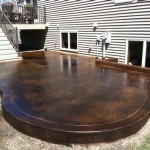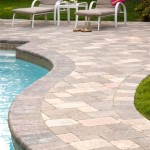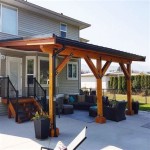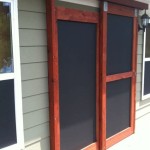How To Build A Small Patio
Constructing a small patio can significantly enhance outdoor living space and increase property value. It provides a dedicated area for relaxation, entertainment, and dining. Careful planning, material selection, and execution are crucial for a successful patio build. This article outlines the process involved in creating a small patio, from initial planning to final finishing touches.
Before commencing any physical work, thorough planning is paramount. This stage involves determining the patio's purpose, selecting a suitable location, defining the dimensions, and creating a detailed design. Consider local building codes and regulations, which may require permits or adherence to specific construction standards.
The location of the patio should be chosen based on factors such as sunlight exposure, proximity to the house, privacy, and existing landscaping. A location that receives ample sunlight during the day may be desirable for sunbathing, while a shaded area might be preferable for relaxation during hot weather. Proximity to the house ensures easy access for carrying food, drinks, and furniture. Strategic placement of trees, shrubs, or fences can provide privacy from neighbors and create a more secluded atmosphere.
The dimensions of the patio should be proportionate to the size of the house and the available yard space. A small patio typically ranges from 8x8 feet to 12x12 feet, accommodating a small table and chairs. Larger patios may be suitable for larger gatherings or outdoor kitchens. Accurately measuring the space and marking the boundaries with stakes and string is essential to ensure proper alignment and prevent costly mistakes.
The design of the patio should reflect personal preferences and complement the overall aesthetic of the house. Consider the shape, layout, and materials used. Common shapes for small patios include squares, rectangles, circles, and semi-circles. The layout should incorporate pathways, seating areas, and potentially focal points such as a fire pit or water feature. Material selection plays a crucial role in the patio's appearance, durability, and cost.
Preparation of the Site
Once the planning phase is complete, the next step involves preparing the site. This includes clearing the area, excavating the soil, and installing a stable base. Properly preparing the site is crucial for preventing settling, cracking, and weed growth.
Clearing the area involves removing all vegetation, rocks, and debris from the designated patio location. This may require using shovels, rakes, and wheelbarrows. Ensure that the area is completely free of any organic matter that could decompose and cause the patio to sink over time.
Excavating the soil involves digging down to a depth that allows for the installation of a proper base. The depth will vary depending on the type of material used for the patio and the local climate. Generally, a depth of 6 to 8 inches is recommended for most small patios. Use a shovel and wheelbarrow to remove the excavated soil, and ensure that the area is level using a spirit level or laser level.
Installing a stable base involves laying down a layer of compacted gravel or crushed stone. This base provides a solid foundation for the patio material and helps to prevent water from pooling underneath. The thickness of the base should be at least 4 inches. Spread the gravel evenly over the excavated area and compact it using a plate compactor or hand tamper. Ensure that the base is level and smooth before proceeding to the next step.
Material Selection and Installation
The choice of patio material significantly impacts the overall appearance, durability, and cost of the project. Common materials include pavers, flagstone, concrete, brick, and gravel. Each material has its own advantages and disadvantages, and the selection should be based on personal preferences, budget constraints, and the desired aesthetic.
Pavers are manufactured concrete or clay units that come in a variety of shapes, sizes, and colors. They are durable, relatively easy to install, and offer a wide range of design possibilities. Pavers are typically laid on a bed of sand over a compacted gravel base. The joints between the pavers are filled with sand or polymeric sand to provide stability and prevent weed growth.
Flagstone is a natural stone that is quarried and cut into irregular shapes. It is a durable and aesthetically pleasing material that provides a natural, rustic look. Flagstone is typically laid on a bed of mortar over a concrete base. The joints between the stones are filled with mortar to create a durable and stable surface.
Concrete is a versatile material that can be poured into various shapes and sizes. It is durable, low-maintenance, and relatively inexpensive. Concrete patios can be finished in a variety of ways, including staining, stamping, and texturing. Concrete is typically poured over a compacted gravel base and reinforced with wire mesh or rebar to prevent cracking.
Brick is a classic material that is durable, aesthetically pleasing, and relatively easy to install. Brick patios can be laid in a variety of patterns, such as herringbone, basketweave, and running bond. Brick is typically laid on a bed of sand over a compacted gravel base. The joints between the bricks are filled with sand or mortar.
Gravel is an inexpensive and easy-to-install material that provides a rustic, natural look. Gravel patios are typically made with crushed stone or pea gravel. A weed barrier fabric is placed under the gravel to prevent weed growth. Gravel patios are not as durable as other materials and may require occasional maintenance to replenish the gravel.
The installation process will vary depending on the chosen material. For pavers, flagstone, and brick, it is essential to create a level and stable surface before laying the material. Use a rubber mallet to gently tap the pavers, flagstone, or brick into place. Ensure that the joints are consistent and that the surface is even. For concrete, it is essential to pour the concrete evenly and screed it to create a smooth surface. Use a float and trowel to finish the concrete surface.
Finishing Touches and Maintenance
After the patio material has been installed, several finishing touches can enhance its appearance and functionality. This includes adding edging, filling the joints, and sealing the surface. Regular maintenance is essential to keep the patio looking its best and prevent damage.
Edging helps to define the perimeter of the patio and prevent the patio material from shifting or spreading. Common edging materials include brick, stone, wood, and plastic. The edging should be installed securely and flush with the patio surface.
Filling the joints between the pavers, flagstone, or brick is essential to provide stability and prevent weed growth. Sand or polymeric sand can be used for pavers and brick, while mortar is typically used for flagstone. Ensure that the joints are completely filled and that the surface is clean.
Sealing the patio surface can help to protect it from stains, water damage, and fading. Sealants are available for various materials, including concrete, pavers, flagstone, and brick. Apply the sealant according to the manufacturer's instructions. Reapply the sealant periodically to maintain its protective properties.
Regular maintenance involves sweeping the patio to remove debris, washing it with soap and water to remove stains, and repairing any cracks or damage. Weeds should be removed promptly to prevent them from spreading. Furniture should be protected from the elements to prevent fading and damage.
Building a small patio is a manageable project that can add significant value and enjoyment to a home. By carefully planning the design, preparing the site properly, selecting durable materials, and performing regular maintenance, it is possible to create an attractive and functional outdoor space for years to come.

How To Build A Small Freestanding Deck So Much Better With Age

How To Build A Patio In Weekend Finegardening

How To Build A Small Freestanding Deck So Much Better With Age

How To Build A Patio In Weekend

How To Build A Simple Diy Deck On Budget The Home Depot

How To Build A Simple Diy Deck On Budget The Home Depot

How To Build A Small Freestanding Deck Backyard Decks Patio

How To Build A Diy Backyard Patio With Pavers Keeping It Simple

How To Build A Small Backyard Patio Dengarden

Small Front Yard Patio Diy Average But Inspired
Related Posts








